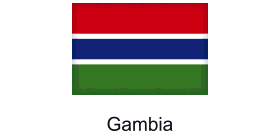 The Gambia’s Tourism: From Humble Beginnings to a Rising Star in West Africa’s Travel Landscape
The Gambia’s Tourism: From Humble Beginnings to a Rising Star in West Africa’s Travel Landscape
Once a modest winter escape for European visitors, The Gambia’s tourism sector has undergone a remarkable transformation, evolving into a dynamic and resilient pillar of the country’s economy. Its unique blend of natural beauty, cultural richness, and strategic initiatives now positions it as a standout destination in West Africa, offering fresh opportunities for the continent’s travel industry.
The journey began in the mid-1960s when a small group of Swedish tourists, led by visionary Bertil Harding, discovered The Gambia’s inviting beaches and warm climate. This pioneering moment sparked the country’s entry into international tourism, with visitor numbers growing steadily through the 1970s as The Gambia became known as an affordable, authentic African getaway for Europeans seeking winter sun. By the late 1970s, arrivals had surged from a few hundred to tens of thousands, signaling the sector’s growing importance to the national economy.
Despite political and economic challenges in the 1980s and 1990s, tourism remained a vital source of foreign exchange and employment. However, infrastructure development struggled to keep pace with demand, and the sector faced hurdles such as seasonal fluctuations and limited diversification beyond the coastal resorts. The early 2000s marked a turning point, with increased investment in infrastructure, marketing, and the introduction of new tourism products like eco-tourism and cultural heritage experiences. This period laid the groundwork for a more mature and varied tourism offering.
Today, The Gambia’s tourism sector is characterized by steady growth and a strategic push towards diversification and sustainability. International arrivals have rebounded strongly post-pandemic, with 2023 seeing over 200,000 air arrivals—a 13% increase from the previous year—and a remarkable 46% surge in the first quarter of 2025, making The Gambia one of the fastest-growing destinations globally. This growth reflects both the country’s appeal and the effectiveness of government-led initiatives aimed at broadening the tourism base beyond traditional European markets.
Central to The Gambia’s unique appeal is its compact size and accessibility. The country’s pristine, uncrowded beaches along the Atlantic coast offer a tranquil alternative to more commercialized destinations. The Gambia River, winding through the heart of the nation, provides a distinctive backdrop for river cruises, birdwatching, and wildlife safaris, showcasing a rich biodiversity that includes chimpanzees, hippos, and over 560 bird species. Nature reserves like Bijilo Forest Park and River Gambia National Park attract eco-tourists seeking immersive experiences in unspoiled environments.
Cultural heritage also plays a pivotal role in The Gambia’s tourism identity. Sites such as Kunta Kinteh Island, a UNESCO World Heritage Site linked to the transatlantic slave trade and popularized by Alex Haley’s “Roots,” offer profound historical insights. The ancient Senegambian stone circles and the sacred Kachikally Crocodile Pool provide visitors with unique encounters that blend history, spirituality, and local traditions. These attractions, combined with vibrant festivals, music, and community-based tourism initiatives, create authentic experiences that resonate with culturally curious travelers.
Recognizing the need to build resilience and inclusivity, The Gambia’s government has launched ambitious programs to diversify tourism products and improve infrastructure. The Tourism Diversification and Resilience Project, backed by a substantial World Bank grant, focuses on strengthening policy frameworks, supporting small and medium enterprises, and enhancing climate resilience—particularly in vulnerable coastal areas. The Tourism Development Master Plan 2020-2025 further emphasizes sustainable growth, infrastructure upgrades, and the promotion of niche markets such as adventure tourism, sport fishing, and rural community experiences.
Infrastructure improvements are underway, with efforts to modernize Banjul International Airport and expand road networks connecting key tourist sites. These upgrades aim to enhance accessibility and visitor experience, addressing past limitations that have constrained growth. Additionally, The Gambia is exploring public-private partnerships to inject capital and expertise into airport management, inspired by successful models in comparable West African nations.
Marketing strategies are evolving to target emerging markets beyond Europe, including travelers from Africa, Asia, and the Middle East. This geographic diversification reduces dependency on traditional source markets and taps into the rising African middle class and global travel trends. Digital transformation plays a key role, with increased use of social media and data analytics to tailor campaigns and improve market reach.
Despite these positive developments, challenges remain. The sector grapples with seasonality, environmental sustainability concerns, and the need to better integrate local communities and women into the tourism value chain. Addressing these issues is critical to ensuring that tourism growth translates into broad-based economic benefits and preserves The Gambia’s natural and cultural assets for future generations.
Looking ahead, The Gambia’s tourism sector is poised for continued expansion and innovation. Its commitment to sustainable, community-centered tourism, combined with strategic investments in infrastructure and market diversification, positions it as a compelling destination for travelers seeking authentic African experiences. For the wider African travel industry, The Gambia offers a model of how small nations can leverage their unique assets and proactive policies to carve out a competitive niche in a rapidly evolving global tourism landscape.
As The Gambia continues to open its doors wider and enhance its offerings, the country’s role as a gateway to West Africa and a hub for eco-cultural tourism is set to strengthen. This evolution not only benefits The Gambia but also enriches the continent’s diverse tourism tapestry, inviting African travel professionals to explore new partnerships and opportunities in one of the region’s most promising destinations.
